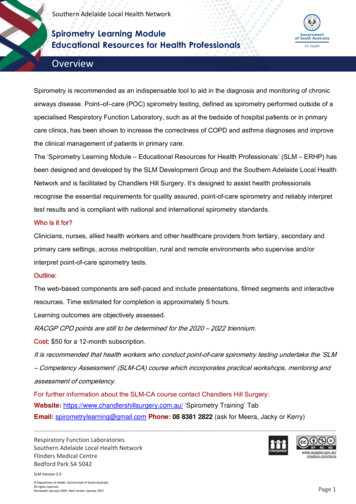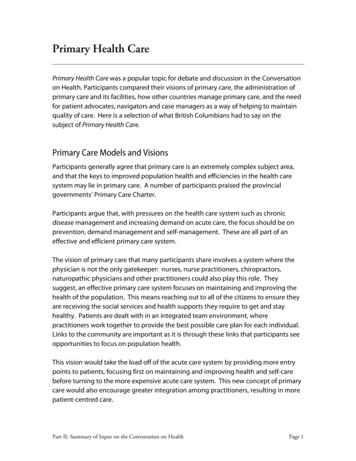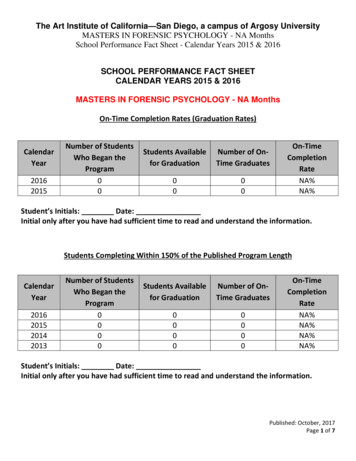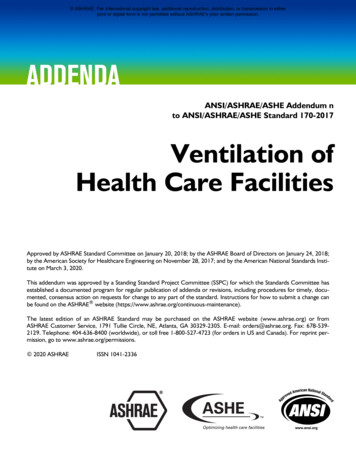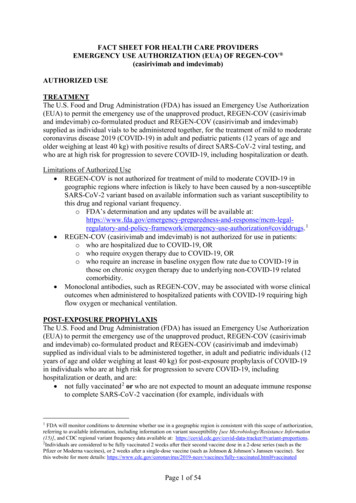
Transcription
FACT SHEET FOR HEALTH CARE PROVIDERSEMERGENCY USE AUTHORIZATION (EUA) OF REGEN-COV (casirivimab and imdevimab)AUTHORIZED USETREATMENTThe U.S. Food and Drug Administration (FDA) has issued an Emergency Use Authorization(EUA) to permit the emergency use of the unapproved product, REGEN-COV (casirivimaband imdevimab) co-formulated product and REGEN-COV (casirivimab and imdevimab)supplied as individual vials to be administered together, for the treatment of mild to moderatecoronavirus disease 2019 (COVID-19) in adult and pediatric patients (12 years of age andolder weighing at least 40 kg) with positive results of direct SARS-CoV-2 viral testing, andwho are at high risk for progression to severe COVID-19, including hospitalization or death.Limitations of Authorized Use REGEN-COV is not authorized for treatment of mild to moderate COVID-19 ingeographic regions where infection is likely to have been caused by a non-susceptibleSARS-CoV-2 variant based on available information such as variant susceptibility tothis drug and regional variant frequency.o FDA’s determination and any updates will be available emergency-use-authorization#coviddrugs. 1 REGEN-COV (casirivimab and imdevimab) is not authorized for use in patients:o who are hospitalized due to COVID-19, ORo who require oxygen therapy due to COVID-19, ORo who require an increase in baseline oxygen flow rate due to COVID-19 inthose on chronic oxygen therapy due to underlying non-COVID-19 relatedcomorbidity. Monoclonal antibodies, such as REGEN-COV, may be associated with worse clinicaloutcomes when administered to hospitalized patients with COVID-19 requiring highflow oxygen or mechanical ventilation.POST-EXPOSURE PROPHYLAXISThe U.S. Food and Drug Administration (FDA) has issued an Emergency Use Authorization(EUA) to permit the emergency use of the unapproved product, REGEN-COV (casirivimaband imdevimab) co-formulated product and REGEN-COV (casirivimab and imdevimab)supplied as individual vials to be administered together, in adult and pediatric individuals (12years of age and older weighing at least 40 kg) for post-exposure prophylaxis of COVID-19in individuals who are at high risk for progression to severe COVID-19, includinghospitalization or death, and are: not fully vaccinated 2 or who are not expected to mount an adequate immune responseto complete SARS-CoV-2 vaccination (for example, individuals with1FDA will monitor conditions to determine whether use in a geographic region is consistent with this scope of authorization,referring to available information, including information on variant susceptibility [see Microbiology/Resistance Information(15)], and CDC regional variant frequency data available at: proportions.2Individuals are considered to be fully vaccinated 2 weeks after their second vaccine dose in a 2-dose series (such as thePfizer or Moderna vaccines), or 2 weeks after a single-dose vaccine (such as Johnson & Johnson’s Janssen vaccine). Seethis website for more details: /fully-vaccinated.html#vaccinatedPage 1 of 54
immunocompromising conditions including those taking immunosuppressivemedications 3) ando have been exposed to an individual infected with SARS-CoV-2 consistentwith close contact criteria per Centers for Disease Control and Prevention(CDC) 4 oro who are at high risk of exposure to an individual infected with SARS-CoV-2because of occurrence of SARS-CoV-2 infection in other individuals in thesame institutional setting (for example, nursing homes, prisons) [seeLimitations of Authorized Use (1.2)].Limitations of Authorized Use REGEN-COV is not authorized for post-exposure prophylaxis of COVID-19 ingeographic regions where exposure is likely to have been to a non-susceptible SARSCoV-2 variant, based on available information including variant susceptibility to thisdrug and regional variant frequency.oFDA’s determination and any updates will be available emergency-use-authorization#coviddrugs. 5 Post-exposure prophylaxis with REGEN-COV (casirivimab and imdevimab) is not asubstitute for vaccination against COVID-19. REGEN-COV (casirivimab and imdevimab) is not authorized for pre-exposureprophylaxis for prevention of COVID-19.RECENT MAJOR CHANGES Limitations of Authorized Use: updated Limitations of AuthorizedUse for treatment and post-exposure prophylaxis Box-Removed SARS-CoV-2 viral variant sectionRevised 1/2022Antiviral Resistance (Section 15): addition of information onsusceptibility of SARS-CoV-2 variants to REGEN-COV(Tables 9 and 10) and updates based on latest viral surveillancereportRevised 12/2021, 8/2021Dosage and Administration (Section 2.4) and How Supplied/Storage and Handling (Section 19): updated storage temperaturerange and durationRevised 11/2021Dosage and Administration (Box, Section 2.4, Section 3,Section 19): addition of co-packaged cartonRevised 09/2021Dosage and Administration (Section 2.4): addition of 5% Dextroseas diluentRevised 09/2021Authorized Use: addition of new indication for post-exposure 3Revised 1/2022See this website for more details: science-briefs/fully-vaccinatedpeople.html4Close contact with an infected individual is defined as: being within 6 feet for a total of 15 minutes or more, providing careat home to someone who is sick, having direct physical contact with the person (hugging or kissing, for example), sharingeating or drinking utensils, or being exposed to respiratory droplets from an infected person (sneezing or coughing, forexample). See this website for additional details: resick/quarantine.html5 FDA will monitor conditions to determine whether use in a geographic region is consistent with this scope of authorization,referring to available information, including information on variant susceptibility [see Microbiology/Resistance Information(15)], and CDC regional variant frequency data available at: proportions.Page 2 of 54
prophylaxis of COVID-19Revised 07/2021Dosage and Administration (Box, and Section 2.2): updatedauthorized dosage for post-exposure prophylaxis of COVID-19Revised 07/2021Authorized Use: expanded the definition of progression of severeCOVID-19 to include deathRevised 06/2021Dosage and Administration (Box, and Section 2.2): updatedauthorized dosageRevised 06/2021Dosage and Administration (Box, Section 2.2 and 2.4): updated withsubcutaneous route of administration as an alternative for those whocannot receive intravenous infusionRevised 06/2021Dosage and Administration (Box, Section 2.2 and 2.4): updated withco-formulationRevised 06/2021Warnings: Hypersensitivity Including Anaphylaxis and InfusionRelated Reactions (Section 5.1): addition of vasovagal reactionsRevised 06/2021Overall Safety Summary, Clinical Trials Experience (Section 6.1):addition of Phase 3 results and safety with subcutaneous dosingRevised 06/2021Clinical Trial Results and Supporting Data for EUA, Mild toModerate COVID-19 (Section 18.1): addition of Phase 3 data forthe authorized doseRevised 06/2021Dosage and Administration (Box and Section 2.1): updatedhigh risk criteria for patient selectionRevised 05/2021Dose Preparation and Administration Instructions (Section 2.4):provides updated minimum infusion times based on size ofinfusion bag usedRevised 03/2021New proprietary name: REGEN-COVRevised 02/2021Warnings: Hypersensitivity Including Anaphylaxis andInfusion-Related Reactions (Section 5.1) – addition of newsymptomsRevised 02/2021Warnings: Clinical Worsening After REGEN-COVAdministration (Section 5.2) – new warning addedRevised 02/2021REGEN-COV has been authorized by FDA for the emergency uses described above.REGEN-COV is not FDA-approved for these uses.REGEN-COV is authorized only for the duration of the declaration that circumstances existjustifying the authorization of the emergency use of REGEN-COV under section 564(b)(1) ofthe Act, 21 U.S.C. § 360bbb-3(b)(1), unless the authorization is terminated or revokedsooner.TreatmentThis EUA is for the use of the unapproved product, REGEN-COV (casirivimab andimdevimab) co-formulated product and REGEN-COV (casirivimab and imdevimab)supplied as individual vials to be administered together, for the treatment of mild tomoderate COVID-19 in adult and pediatric patients (12 years of age and olderweighing at least 40 kg) with positive results of direct SARS-CoV-2 viral testing, andwho are at high risk for progression to severe COVID-19, including hospitalization ordeath [see Limitations of Authorized Use (1.1)].Page 3 of 54
Post-Exposure ProphylaxisThis EUA is for the use of the unapproved product, REGEN-COV (casirivimab andimdevimab) co-formulated product and REGEN-COV (casirivimab and imdevimab)supplied as individual vials to be administered together, in adult and pediatricindividuals (12 years of age and older weighing at least 40 kg) for post-exposureprophylaxis of COVID-19 in individuals who are at high risk for progression tosevere COVID-19, including hospitalization or death, and are: not fully vaccinated2 or who are not expected to mount an adequate immuneresponse to complete SARS-CoV-2 vaccination (for example, individuals withimmunocompromising conditions including those taking immunosuppressivemedications3) and- have been exposed to an individual infected with SARS-CoV-2consistent with close contact criteria per Center for Disease Controland Prevention (CDC)4 orwho are at high risk of exposure to an individual infected with SARSCoV-2 because of occurrence of SARS-CoV-2 infection in otherindividuals in the same institutional setting (for example, nursinghomes, prisons) [see Limitations of Authorized Use (1.2)].Criteria for Identifying High Risk IndividualsThe following medical conditions or other factors may place adults and pediatric patients(age 12-17 years and weighing at least 40 kg) at higher risk for progression to severeCOVID-19: Older age (for example, age 65 years of age) Obesity or being overweight (for example, BMI 25 kg/m2, or if age 12-17, haveBMI 85th percentile for their age and gender based on CDC growth charts,https://www.cdc.gov/growthcharts/clinical charts.htm) Pregnancy Chronic kidney disease Diabetes Immunosuppressive disease or immunosuppressive treatment Cardiovascular disease (including congenital heart disease) or hypertension Chronic lung diseases (for example, chronic obstructive pulmonary disease, asthma[moderate-to-severe], interstitial lung disease, cystic fibrosis and pulmonaryhypertension) Sickle cell disease Neurodevelopmental disorders (for example, cerebral palsy) or other conditions thatconfer medical complexity (for example, genetic or metabolic syndromes andsevere congenital anomalies) Having a medical-related technological dependence (for example, tracheostomy,gastrostomy, or positive pressure ventilation (not related to COVID-19))Other medical conditions or factors (for example, race or ethnicity) may also placeindividual patients at high risk for progression to severe COVID-19 and authorization ofREGEN-COV under the EUA is not limited to the medical conditions or factors listedabove. For additional information on medical conditions and factors associated withincreased risk for progression to severe COVID, see the CDC website:Page 4 of 54
ra-precautions/people-with-medicalconditions.html. Healthcare providers should consider the benefit-risk for an individualpatient.Available Dosage Forms of REGEN-COV:REGEN-COV (casirivimab and imdevimab) is available as:1. A single vial which contains two antibodies co-formulated in a 1:1 ratio ofcasirivimab and imdevimab or2. Individual antibody solutions in separate vials, which may be supplied in separatecartons or together in a single carton (also referred to as a co-packaged carton), orin a dose pack.Routes of Administration for REGEN-COV:REGEN-COV may be administered by intravenous infusion or subcutaneous injection.FOR TREATMENT, INTRAVENOUS INFUSION IS STRONGLYRECOMMENDED. SUBCUTANEOUS INJECTION IS AN ALTERNATIVEROUTE OF ADMINISTRATION WHEN INTRAVENOUS INFUSION IS NOTFEASIBLE AND WOULD LEAD TO DELAY IN TREATMENT.FOR POST-EXPOSURE PROPHYLAXIS, EITHER SUBCUTANEOUSINJECTION OR INTRAVENOUS INFUSION CAN BE USED.Treatment Dosage The authorized dosage is 600 mg of casirivimab and 600 mg of imdevimabadministered together as a single intravenous infusion or by subcutaneous injectionas soon as possible after positive SARS-CoV-2 viral testing and within 10 days ofsymptom onset [see Dosage and Administration (2.2) and Clinical Trial Results andSupporting Data for EUA (18.1)]. The authorized dosage of 600 mg of casirivimab and 600 mg of imdevimab forsubcutaneous administration for treatment is selected based on the totality of thescientific evidence, incorporating clinical data, viral load reduction data(pharmacodynamics) and pharmacokinetic data [see Clinical Pharmacology (14.2)and (14.3)].Post-exposure Prophylaxis Dosage The authorized dosage is 600 mg of casirivimab and 600 mg of imdevimabadministered by subcutaneous injection or together as a single intravenous infusionas soon as possible following exposure to SARS-CoV-2. For individuals in whom repeat dosing is determined to be appropriate for ongoingexposure to SARS-CoV-2 for longer than 4 weeks and who are not expected tomount an adequate immune response to complete SARS-CoV-2 vaccination, theinitial dose is 600 mg of casirivimab and 600 mg of imdevimab by subcutaneousinjection or intravenous infusion followed by subsequent repeat dosing of 300 mgof casirivimab and 300 mg of imdevimab by subcutaneous injection or intravenousinfusion once every 4 weeks for the duration of ongoing exposure.Page 5 of 54
The authorized dosage including dosage for repeat dosing is based on the totality ofthe scientific evidence including clinical pharmacology data and clinical trial data[see Clinical Trial Results and Supporting Data for EUA (18.2) and ClinicalPharmacology (14.3)].For Intravenous Infusion: Co-formulated casirivimab and imdevimab solution in a vial and casirivimab andimdevimab solutions in individual vials must be diluted prior to intravenousadministration. Administer casirivimab and imdevimab together as a single intravenous infusionvia pump or gravity (see Table 1, Table 2, Table 3 and Table 4). Clinically monitor patients during infusion and observe patients for at least 1 hourafter infusion is complete.For Subcutaneous Injection: Administer casirivimab and imdevimab using the co-formulated solution in a vialor using the individual vials (see Table 5 and Table 6). Clinically monitor patients after injections and observe patients for at least 1 hourafter injections. For treatment, subcutaneous injection is an alternative route of administration whenintravenous administration is not feasible and would lead to delay in treatment. Forpost-exposure prophylaxis, either subcutaneous injection or intravenous infusion canbe administered.REGEN-COV may only be administered in settings in which health care providers haveimmediate access to medications to treat a severe infusion or hypersensitivity reactions,such as anaphylaxis, and the ability to activate the emergency medical system (EMS), asnecessary.Health care providers must submit a report on ALL MEDICATION ERRORS and ALLSERIOUS ADVERSE EVENTS potentially related to REGEN-COV. See Sections 8 and9 of the Full EUA Prescribing Information for reporting instructions below. Patients treated with REGEN-COV should continue to self-isolate and use infectioncontrol measures (e.g., wear mask, isolate, social distance, avoid sharing personalitems, clean and disinfect “high touch” surfaces, and frequent handwashing)according to CDC guidelines.The authorized dosage may be updated as additional data from clinical trials becomesavailable.For information on clinical trials that are testing the use of REGEN-COV in COVID-19,please see www.clinicaltrials.gov.ContraindicationsREGEN-COV is contraindicated in individuals with previous severe hypersensitivityreactions, including anaphylaxis, to REGEN-COV [see Warnings and Precautions (5.1)].Page 6 of 54
DosingPatient Selection for Treatment and Post-Exposure ProphylaxisThis section provides essential information on the unapproved product, REGEN-COV(casirivimab and imdevimab) co-formulated product and REGEN-COV (casirivimab andimdevimab) supplied in individual vials to be administered together in adult and pediatricpatients (12 years of age and older weighing at least 40 kg) who are at high risk forprogression to severe COVID-19, including hospitalization or death for: Treatment of mild to moderate COVID-19 in adult and pediatric patients with positiveresults of direct SARS-CoV-2 viral testing [see Limitations of Authorized Use (1.1)]. Post-exposure prophylaxis of COVID-19 in high risk individuals who are: not fully vaccinated2 or who are not expected to mount an adequate immuneresponse to complete SARS-CoV-2 vaccination (for example, individuals withimmunocompromising conditions including those taking immunosuppressivemedications3) and- have been exposed to an individual infected with SARS-CoV-2consistent with close contact criteria per Centers for Disease Controland Prevention (CDC)4 or- who are at high risk of exposure to an individual infected with SARSCoV-2 because of occurrence of SARS-CoV-2 infection in otherindividuals in the same institutional setting (for example, nursinghomes, prisons) [see Limitations of Authorized Use (1.2)].Criteria for Identifying High Risk IndividualsThe following medical conditions or other factors may place adults and pediatric patients(age 12-17 years and weighing at least 40 kg) at higher risk for progression to severeCOVID-19: Older age (for example, age 65 years of age) Obesity or being overweight (for example, BMI 25 kg/m2, or if age 12-17, have BMI 85th percentile for their age and gender based on CDC growth charts,https://www.cdc.gov/growthcharts/clinical charts.htm) Pregnancy Chronic kidney disease Diabetes Immunosuppressive disease or immunosuppressive treatment Cardiovascular disease (including congenital heart disease) or hypertension Chronic lung diseases (for example, chronic obstructive pulmonary disease, asthma[moderate-to-severe], interstitial lung disease, cystic fibrosis and pulmonaryhypertension) Sickle cell disease Neurodevelopmental disorders (for example, cerebral palsy) or other conditions thatconfer medical complexity (for example, genetic or metabolic syndromes and severecongenital anomalies) Having a medical-related technological dependence (for example, tracheostomy,gastrostomy, or positive pressure ventilation (not related to COVID-19))Page 7 of 54
Other medical conditions or factors (for example, race or ethnicity) may also place individualpatients at high risk for progression to severe COVID-19 and authorization of REGEN-COVunder the EUA is not limited to the medical conditions or factors listed above. For additionalinformation on medical conditions and factors associated with increased risk for progressionto severe COVID-19, see the CDC website: a-precautions/people-with-medical-conditions.html. Healthcare providersshould consider the benefit-risk for an individual patient.DosageTreatment:The dosage in adult and pediatric patients (12 years of age and older weighing at least 40 kg) is600 mg of casirivimab and 600 mg of imdevimab administered together as a singleintravenous infusion or by subcutaneous injection. Casirivimab and imdevimab should begiven together as soon as possible after positive results of direct SARS-CoV-2 viral testing andwithin 10 days of symptom onset.Post-Exposure Prophylaxis:The dosage in adult and pediatric individuals (12 years of age and older weighing at least 40kg) is 600 mg of casirivimab and 600 mg of imdevimab administered by subcutaneousinjection or together as a single intravenous infusion. Casirivimab and imdevimab should begiven together as soon as possible following exposure to SARS-CoV-2.For individuals in whom repeat dosing is determined to be appropriate for ongoing exposure toSARS-CoV-2 for longer than 4 weeks and who are not expected to mount an adequateimmune response to complete SARS-CoV-2 vaccination, the initial dose is 600 mg ofcasirivimab and 600 mg of imdevimab by subcutaneous injection or intravenous infusionfollowed by subsequent repeat dosing of 300 mg of casirivimab and 300 mg of imdevimab bysubcutaneous injection or intravenous infusion once every 4 weeks for the duration ofongoing exposure.For Intravenous Infusion: Casirivimab and imdevimab solution co-formulated in a vial and in individual vials,including co-packaged carton and dose pack, must be diluted prior to intravenousadministration. Administer casirivimab and imdevimab together as a single intravenous infusion viapump or gravity (see Table 1, Table 2, Table 3 and Table 4). Clinically monitor patients during infusion and observe patients for at least 1 hourafter infusion is complete.For Subcutaneous Injection: Administer casirivimab and imdevimab using the co-formulated vial or using theindividual vials by subcutaneous injection (see Table 5 and Table 6). Clinically monitor patients after injections and observe patients for at least 1 hour.Dosage Adjustment in Specific PopulationsNo dosage adjustment is recommended in pregnant or lactating women and in patients withrenal impairment [see Full EUA Prescribing Information, Use in Specific Populations (11)].Page 8 of 54
Preparation and AdministrationThere are TWO different formulations of REGEN-COV: Casirivimab and imdevimab co-formulated solution containing two antibodies in a 1:1ratio in a vial. Casirivimab and imdevimab available as individual antibody solutions in separatevials supplied as follows:o Individual vials in individual cartons, oro together in a single carton (as referred to as a co-packaged carton), oro in a dose pack. The dose pack contains individual vials of casirivimab andimdevimab, configurations that may vary in vial size, strength and appearance andare available in dose pack configurations that include 2, 5, and 8 cartons [see FullEUA Prescribing Information, How Supplied/Storage and Handling (19)].For treatment, intravenous infusion is strongly recommended. Subcutaneous injection isan alternative route of administration when intravenous infusion is not feasible andwould lead to delay in treatment.For post-exposure prophylaxis, either subcutaneous injection or intravenous infusioncan be used.There are differences in the way the two formulations are prepared. Carefully follow thepreparation procedures below. Casirivimab and imdevimab co-formulated solution in a vial and casirivimab orimdevimab as individual antibody solutions in separate 11.1 mL vials may be used toprepare more than one dose simultaneously as appropriate, either in intravenous bagsor in syringes for subcutaneous injection. Discard any product remaining in the vial. Store unopened casirivimab and imdevimab vials in a refrigerator at 2 C to 8 C (36 Fto 46 F) in the original carton to protect from light. Unopened vials may be stored inthe original carton at room temperature [up to 25 C (77 F)] and must be used within30 days. If not used in the 30 days, discard vials.Under the EUA, a single-dose vial may be used to prepare more than one dose.Preparation for Intravenous InfusionFor treatment, the preferred route of administration for casirivimab and imdevimab is byintravenous infusion after dilution.Casirivimab and imdevimab solution for intravenous infusion should be prepared by aqualified healthcare professional using aseptic technique:1. Remove the casirivimab and imdevimab vials from refrigerated storage and allow toequilibrate to room temperature for approximately 20 minutes before preparation. Donot expose to direct heat. Do not shake the vials.2. Inspect casirivimab and imdevimab vials visually for particulate matter anddiscoloration prior to administration. Should either be observed, the vial must bediscarded and replaced with a new vial. The solution for each vial should be clear to slightly opalescent, colorless to paleyellow.Page 9 of 54
3. Obtain a prefilled intravenous infusion bag containing either 50 mL, 100 mL, 150 mL,or 250 mL of either 0.9% Sodium Chloride Injection, USP or 5% Dextrose Injection,USP.4. Withdraw the appropriate amount of casirivimab and imdevimab from each respectivevial(s) and inject into a prefilled infusion bag containing either 0.9% Sodium ChlorideInjection, USP or 5% Dextrose Injection, USP (see Table 1 and Table 2). If using onevial to prepare more than one infusion bag, then prepare all infusion bags at the sametime. The product is preservative-free, therefore do not store unused solution invial(s).5. Gently invert infusion bag by hand approximately 10 times to mix. Do not shake.6. This product is preservative-free and therefore, the diluted infusion solution should beadministered immediately (see Table 3 and Table 4). If immediate administration is not possible, store the diluted casirivimab andimdevimab infusion solution in the refrigerator between 2 C to 8 C (36 F to46 F) for no more than 36 hours or at room temperature up to 25 C (77 F) for nomore than 4 hours. If refrigerated, allow the infusion solution to equilibrate toroom temperature for approximately 30 minutes prior to administration.Table 1:Recommended Dilution Instructions for 600 mg of Casirivimab and 600mg of Imdevimab for Intravenous InfusionSize of Prefilled0.9% SodiumChloride or 5%Dextrose InfusionBagPreparing Using CoFormulated Casirivimab andImdevimab VialAdd:50 mLAdd 10 mL of co-formulatedcasirivimab and imdevimab (1vial) into a prefilled 0.9%Sodium Chloride or 5% Dextroseinfusion bag and administer asinstructed below100 mL150 mL250 mLaPreparing Casirivimab andImdevimab Using IndividualVialsa 5 mL of casirivimab (may use2 vials of 2.5 mL OR 1 vialof 11.1 mL) and 5 mL of imdevimab (may use2 vials of 2.5 mL OR 1 vialof 11.1 mL)and inject into a prefilled 0.9%Sodium Chloride or 5% Dextroseinfusion bag and administer asinstructed below600 mg of casirivimab and 600 mg of imdevimab are added to the same infusion bag and administeredtogether as a single intravenous infusion.Table 2:Recommended Dilution Instructions for 300 mg of Casirivimab and 300mg of Imdevimab for Intravenous Infusion for Repeat DosingaSize of Prefilled0.9% SodiumChloride or 5%Preparing Using CoFormulated Casirivimab andImdevimab VialPage 10 of 54Preparing Casirivimab andImdevimab Using IndividualVialsb
Dextrose InfusionBagAdd:50 mL100 mL150 mL Add 5 mL of co-formulatedcasirivimab and imdevimab into a prefilled 0.9% Sodium Chlorideor 5% Dextrose infusion bag andadminister as instructed belowb2.5 mL of imdevimab (mayuse 1 vial of 2.5 mL OR 1vial of 11.1 mL)and inject into a prefilled 0.9%Sodium Chloride or 5% Dextroseinfusion bag and administer asinstructed below250 mLa2.5 mL of casirivimab (mayuse 1 vial of 2.5 mL OR 1vial of 11.1 mL) andSubsequent repeat dosing every 4 weeks after initial 600 mg casirivimab and 600 mg imdevimab dosing forthe duration of ongoing exposure.300 mg of casirivimab and 300 mg of imdevimab are added to the same infusion bag and administeredtogether as a single intravenous infusion.Administration by Intravenous InfusionCasirivimab and imdevimab infusion solution should be administered by a qualifiedhealthcare professional using aseptic technique. Gather the recommended materials for infusion:o Polyvinyl chloride (PVC), polyethylene (PE)-lined PVC, or polyurethane(PU) infusion seto In-line or add-on 0.2 micron polyethersulfone (PES) filter Attach the infusion set to the intravenous bag. Prime the infusion set. Administer the entire infusion solution in the bag via pump or gravity through anintravenous line containing a sterile, in-line or add-on 0.2-micron polyethersulfone(PES) filter (see Table 3 and Table 4). Due to potential overfill of prefilled salinebags, the entire infusion solution in the bag should be administered to avoidunderdosage. The prepared infusion solution should not be administered simultaneously with anyother medication. The compatibility of casirivimab and imdevimab injection withintravenous solutions and medications other than 0.9% Sodium Chloride Injection,USP or 5% Dextrose Injection, USP is not known. After infusion is complete, flush the tubing with either 0.9% Sodium ChlorideInjection, USP or 5% Dextrose Injection, USP to ensure delivery of the required dose. Discard unused product. Clinically monitor patients during administration and observe patients for at least 1hour after infusion is complete.Table 3:Recommended Administration Rate for 600 mg of Casirivimab and 600mg of Imdevimab for Intravenous InfusionPage 11 of 54
Size of Prefilled 0.9% SodiumChloride or 5% DextroseInfusion Bag used50 mLa100 mL150 mL250 mLMaximum Infusion RateMinimum Infusion Time180 mL/hr310 mL/hr310 mL/hr310 mL/hr20 minutes21 minutes31 minutes50 minutesThe minimum infusion time for patients administered casirivimab and imdevimab together using the 50 mLprefilled 0.9% Sodium Chloride or 5% Dextrose infusion bag must be at least 20 minutes to ensure safe use.aTable 4:Recommended Administration Rate for 300 mg of Casirivimab and 300mg of Imdevimab for Intravenous Infusion for Repeat DosingaSize of Prefilled 0.9% SodiumChloride or 5% DextroseInfusion Bag used50 mLb100 mL150 mL250 mLMaximum Infusion RateMinimum Infusion Time165 mL/hr310 mL/hr310 mL/hr310 mL/hr20 minutes20 minutes30 minutes49 minutesSubseque
The following medical conditions or other factors may place adults and pediatric patients (age 12-17 years and weighing at least 40 kg) at higher risk for progression to severe COVID-19: Older age (for example, age 65 years of age) Obesity or being overwei




